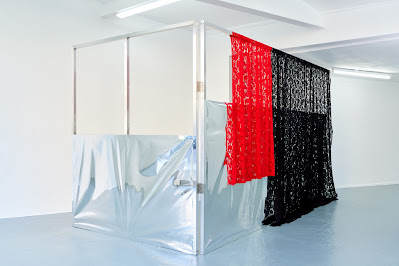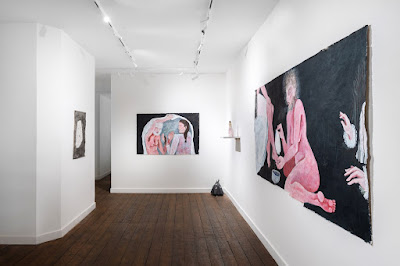Sitara Abuzar Ghaznawi at Auto Italia
Before even considering writing about visual matter, the writer, critic, and indeed viewer, has to position themselves, consciously or otherwise. Having an opinion is not an isolated experience; it derives from various influences including social conditioning, material and immaterial relationships, and one's bond with visual culture institutions. Ultimately, the structures and attitudes of bigotry add prejudice that exist in society at large, as well as the individual's mind, will emerge in the perception of visual stimuli. For example, particularly poisonous anti-migrant rhetoric often reverts to positing cultural symbols, largely visual, as barriers to idylls of white-washing and nationalism. The what and how of our perceptions are essential in understanding the world and those we come into contact with.
There is certainly a sense of some anger in Zurich-based artist Sitara Abuzar Ghaznawi's work, which is currently being shown at Auto Italia in East London, investigating "the classist and racialised structures of hegemonic Western aesthetics". If the viewer hadn't been cognisant of these motifs prior to the show, the artist's use of site-specific installation, sculptures and drawings is a direct reminder. These aesthetics can often fade into the background, especially in busy cities where multicultural identities and communities are largely taken for granted; however they are heightened in geographies such as Brick Lane, which is known for not only its countless South Asian restaurants, eateries and shops, but also a huge density of tourism. The former is part of the street's tourist image and USP, but also caters to the large South Asian community of its borough, Tower Hamlets. Given that Brick Lane is a short walk from Auto Italia, and the exhausting, and exhaustive, commodification of all aspects of culture under capitalism, the case study of Brick Lane is not necessarily mutually exclusive from ideas present in Ghaznawi's latest body of work.
Sitara Abuzar Ghaznawi is an artist from Afghanistan, living and working in Zurich, and yet 'Sin City', her first solo exhibition in the UK, does not seem to have an Afghani framing specifically, instead producing an investigation into how "taste" is shaped by not only one's own culture, but how we respond to other cultures. One particular example might be the vilification, and overt Western disgust, over MSG (monosodium glutamate), which for some time has escalated into obnoxious, and outright racist, attitudes towards South East Asian cooking. This resonates with a recent controversy over on TikTok, whereby in a now-deleted video, Toronto-based influencer Summer Fox released a scathing review of a Chinese restaurant she visited with her boyfriend. Speaking very glibly about the taste and smell of the food not being to their liking, and making almost cartoonish grossed-out expressions to camera, many defending Fox were decrying the importance of "free speech", and that she was within her right to find the food not to her taste. TikTok's more critical respondents were highlighting the privilege of wealth, race and nationality. Whilst social media has form for flippant remarks being stripped of context and proportion, food is an inherent part of many people's cultures, both individual and collective. That which is a simple meal for one person (in this case, a customer), can signify a way of life, a culture, a livelihood and years of honing a craft for another.
Upon entering Auto Italia, an aluminium structure with a reflective surface on one side and black and red lace on the other greets the viewer. The reflective surface is something of a motif, acting as a constant reminder that the classist and racist norms that Ghaznawi discusses through her work are enlivened and performed through the actions and thoughts of people, as opposed to static or abstract ideology, if such a thing exists. The lace has a beautiful element to it, but equally the idea of it being mass-produced and 'cheap' is prevalent, and already we are forced to ask: can the two coexist?
Through to the back space and another installation is almost breath-taking in its simplicity. A slanted piece of metal, similarly reflective but with more of an indistinct, matte finish, obstructs the space, with artificial blue roses lain on the floor, almost lining the sculpture, but facing outwards. The flowers' colour is a perfect choice, as blue roses do not exist in nature, therefore there can be no doubt that they are not real. Does this mean the artwork possesses an inherently lower value? This body of work sees the artist commenting on the negative associations of throwaway materials, which is increasingly validated given the public consciousness around climate degradation. However, with so much production being outsourced to various Global South nations and communities, the xenophobic, racist, classist connotations usually preserved for people then transcend to material goods. One can trace Ghaznawi's smart, visible thought process of tracking the movement of prejudice towards certain groups of people to materials, and back again.
The two main large-scale sculptures are accompanied by drawings and mixed-media works. Again, the artist uses a metallic, reflective material to make the topics and issues in question a concern of the viewer. Many will believe themselves to be anti-racist, but will not ask themselves (and interrogate further as to) what they are doing in practice. A wall-based collage sharing space with the blue roses is a telling comment on a woman's place in this narrative; the bold, seductive red background with silhouettes of women in various states of dancing evokes a strip club aesthetic. As the artist critiques the Western diminution of mass-production and Global South labour as 'cheap' thus denying its status as high-value, we are reminded that much of this work is executed by women, but also that this Othering and exoticising of materials does have a relationship, direct or theoretical, with society's treatment of women. This wall-based collage is arguably not an artwork that conservative art lovers will particularly be drawn to; the shapes and positioning of the reflective material is asymmetrical and disjointed, but this has been done to unapologetically interrogate the ways in which audiences want things to look. Why must objects look a certain way? And what conditioning have we been through that have led us to such thinking?
These questions can be asked in other parts of life as we seek to challenge prejudice in its various nefarious forms, however Ghaznawi's ideas are guided by an interest in how aesthetics are expected to be organised in gallery and museum settings. If an artist is self-taught or not backed academically by one institution or another, their chances of being showcased on a larger platform are drastically reduced. There are different levels of gravity at play in Auto Italia's exhibition, all engaging, thought-provoking and visually exciting. As we are arguably witnessing the institution's decline in authority in recent years, whether that has been due to poor responses to seismic moments such as Black Lives Matter, funding cuts, or other stale values that do not appeal to younger audiences, Ghaznawi hints at what a refreshed "art world" might look like, one that is inspired by real people, real experiences, and is less concerned with an pointlessly glossy facade.






